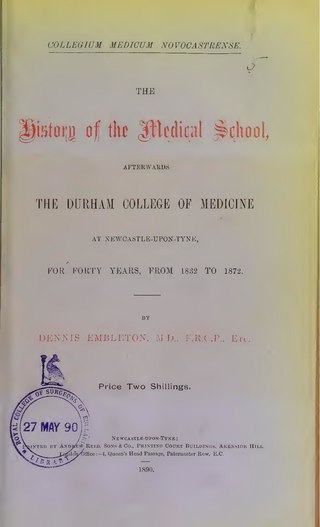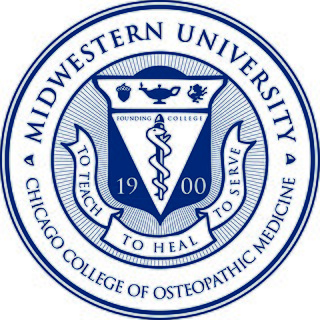A medical school is a tertiary educational institution, professional school, or forms a part of such an institution, that teaches medicine, and awards a professional degree for physicians. Such medical degrees include the Bachelor of Medicine, Bachelor of Surgery, Master of Medicine, Doctor of Medicine (MD), or Doctor of Osteopathic Medicine (DO). Many medical schools offer additional degrees, such as a Doctor of Philosophy (PhD), master's degree (MSc) or other post-secondary education.

St George's, University of London, is a university located in Tooting in South London and is a constituent college of the University of London. St George's hospital has its origins in 1733, and began formal registration of trainee fixtures in 1751. It was the second institution in England to provide formal training courses for doctors. St George's affiliated with the University of London soon after the latter's establishment in 1836.
The University of North Texas Health Science Center is a public academic health science center in Fort Worth, Texas. It is part of the University of North Texas System and was founded in 1966 as the Texas College of Osteopathic Medicine, with its first cohort admitted in 1970. UNT Health Science Center consists of five graduate schools with a total enrollment of 2,329 students (2020–21).

The Cardiff University School of Medicine is the medical school of Cardiff University and is located in Cardiff, Wales, UK. Founded in 1893 as part of the University College of South Wales and Monmouthshire, it is the older of the two medical schools in Wales.

The University of Birmingham Medical School is one of Britain's largest and oldest medical schools with over 400 medical, 70 pharmacy, 140 biomedical science and 130 nursing students graduating each year. It is based at the University of Birmingham in Edgbaston, Birmingham, United Kingdom. Since 2008, the medical school is a constituent of The College of Medical and Dental Sciences.

Brighton and Sussex Medical School (BSMS) is a medical school formed as a partnership of the University of Brighton and the University of Sussex. Like other UK medical schools it is based on the principles and standards of 'Tomorrow's Doctors', an initiative by the General Medical Council outlining the role of British practitioners. Since opening in 2003, BSMS has produced more than 1,500 new doctors who now work across the UK.

Keele University School of Medicine is a medical school located in Newcastle-under-Lyme and Shrewsbury. The first two years of the school's MBChB degree are mostly taught on the Keele University campus, while early contact to patients is critical, and there is significant interaction in a clinical environment from the second-year onwards.

Faculty of Medicine Siriraj Hospital, Mahidol University is the oldest and largest medical school and the oldest of any kind of university faculty in Thailand. The faculty is now part of Mahidol University. Founded in 1889, the faculty was run in co-operation with Siriraj Hospital, the first public hospital in Thailand, which provides students with clinical experience. The faculty's campus and hospital is in the Bangkok Noi District, Bangkok, on the former Rear Palace. The medical school accepts about 250 students for undergraduate education and more than 100 to postgraduate studies each year.

Newcastle University School of Medicine is the medical school at Newcastle University in England. It was established in 1834 in the city of Newcastle upon Tyne and served as the College of Medicine in connection with Durham University from 1851 to 1870 and then, as a full college of the university, Durham University College of Medicine from 1870 to 1937 when it joined Armstrong College, to form King's College, Durham. In 1963 King's College became the University of Newcastle upon Tyne. The university now uses the name "Newcastle University".
Aberdeen University School of Medicine, Medical Sciences & Nutrition contains the Medical School and Dental School at the University of Aberdeen in Scotland. It also provides training and carries out research in medical sciences, nutrition, public health, dentistry, health sciences, physician associate studies at BSc, MSc, and PhD levels. The current school was formed from the merger of the former School of Medicine & Dentistry, School of Medical Sciences, and the Rowett Institute of Nutrition.
Master's degrees in pharmacy comprise both postgraduate and integrated master's programs in pharmacy, the latter of which comprises both undergraduate and postgraduate coursework and typically takes four to five years to complete.
Drexel University College of Medicine is the medical school of Drexel University, a private research university in Philadelphia, Pennsylvania. The medical school represents the consolidation of two medical schools: Hahnemann Medical College, originally founded as the nation's first college of homeopathy, and the Woman's Medical College of Pennsylvania, the first U.S. medical school for women, which became the Medical College of Pennsylvania when it admitted men in 1970; these institutions merged together in 1993, became affiliated with Drexel in 1998, and were fully absorbed into the university in 2002. With one of the nation's largest enrollments for a private medical school, Drexel University College of Medicine is the second most applied-to medical school in the United States. It is ranked no. 83 in research by U.S. News & World Report.

The University of Nottingham Medical School is the medical school of the University of Nottingham, Nottingham, UK. Its first intake of 48 students graduated in 1975. Student intake has steadily increased to a current level of 330 students per year, including 90 from the satellite graduate-entry school at Derby, which opened in 2003.

The University of North Carolina School of Medicine is a professional school within the University of North Carolina at Chapel Hill. It offers a Doctor of Medicine degree along with combined Doctor of Medicine / Doctor of Philosophy or Doctor of Medicine / Master of Public Health degrees.
Keele University School of Allied Health Professions (SAHP) is a teaching department of Keele University, Staffordshire, England. All programmes offered by the school are taught in the MacKay Building on the Keele University campus near Newcastle-under-Lyme. The school also uses facilities at the Keele University Medical School and from the wider university. The school offers educational programmes at undergraduate and postgraduate levels. There is an active research focus within the school with many of the teaching staff being members of Research Institutes at the university. The school is a regional hub of the National Physiotherapy Research Network.

Chicago College of Osteopathic Medicine (CCOM) is the medical school of Midwestern University in Downers Grove, Illinois. CCOM grants the Doctor of Osteopathic Medicine D.O. academic degree and is accredited by the American Osteopathic Association's Commission on Osteopathic College Accreditation (COCA).
The University of Ghana Medical School also UGMS is the medical school of Ghana's first public research institution, the University of Ghana. It is currently located at the Korle Bu Teaching Hospital in Accra. The medical school was first planned in 1919, but took its first students in 1962.

Queen's Campus is a site owned by the University of Durham located in Thornaby-on-Tees in the borough of Stockton-on-Tees, now home to the Durham University International Study Centre.











